STS-107 MCC Status Report #20; Sunday, February 2, 2003 - 8:30
p.m. CST
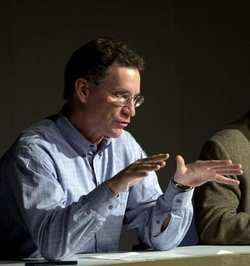 Aided by federal and local agencies, NASA stepped
up its inquiry into the loss of the Space Shuttle Columbia and its
seven astronauts. Multiple investigative teams continue to pore
over engineering data in an effort to uncover the cause of the
breakup of the orbiter over Texas on Saturday 16 minutes from
landing.
Aided by federal and local agencies, NASA stepped
up its inquiry into the loss of the Space Shuttle Columbia and its
seven astronauts. Multiple investigative teams continue to pore
over engineering data in an effort to uncover the cause of the
breakup of the orbiter over Texas on Saturday 16 minutes from
landing.
Space Shuttle Program Manager Ron Dittemore (right) told an
afternoon briefing that a Mishap Response Team is gathering data
from numerous engineering teams in the early stages of the
investigation and is receiving assistance from the Federal
Emergency Management Agency, the National Transportation Safety
Board, the Federal Bureau of Investigation and local law
enforcement agencies, among others.
Dittemore said that as Commander Rick Husband, Pilot William
McCool, Mission Specialists Dave Brown, Kalpana Chawla, Mike
Anderson, Laurel Clark and Israeli Payload Specialist Ilan Ramon
are mourned, the recovery of debris from Columbia and human remains
is being coordinated at Barksdale Air Force Base, La.
Dittemore thanked residents in the areas where debris fell after
Columbia’s breakup for cooperating in the recovery effort but
cautioned them not to handle debris that could contain toxic
substances.
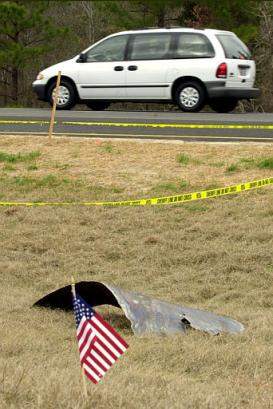 Dittemore reconstructed the final minutes of
Columbia’s flight before communications was lost. He
reiterated the failure of four temperature sensors associated with
the shuttle’s left hand elevons at 7:53 a.m. CST Saturday
amidst a 20-30 degree rise in left hand bondline and strut
temperatures over a five-minute period near the left wheel well of
the orbiter. Columbia was flying over California at the time at an
altitude of about 220,000 feet traveling 21 times the speed of
sound.
Dittemore reconstructed the final minutes of
Columbia’s flight before communications was lost. He
reiterated the failure of four temperature sensors associated with
the shuttle’s left hand elevons at 7:53 a.m. CST Saturday
amidst a 20-30 degree rise in left hand bondline and strut
temperatures over a five-minute period near the left wheel well of
the orbiter. Columbia was flying over California at the time at an
altitude of about 220,000 feet traveling 21 times the speed of
sound.
One minute later, over the region of eastern California and
western Nevada, Columbia’s mid-fuselage bondline temperatures
above the left wing experienced an unusual temperature increase. It
rose 60 degrees over a five-minute period. No such temperature
increase was noted on the right side of Columbia or in the
Shuttle’s cargo bay. Columbia was about 212,000 feet above
the Earth, flying at Mach 20.
At 7:58 a.m. over New Mexico, telemetry showed a larger than
normal drag on the left side of the shuttle, and an indication of
an increase in pressure in the left main landing gear tires.
Dittemore said the data suggests the tires remained intact.
Columbia’s altitude was 209,000 feet.
At 7:59 a.m. over west Texas, the data showed Columbia
continuing to react to an increased drag on its left side, trying
to correct the movement by rolling back to the right. Dittemore
said the response of the orbiter was well within its capability to
handle such maneuvers.
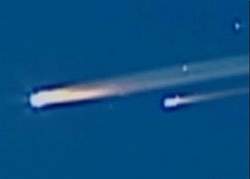 At
that time, seconds before 8 a.m. CST, all communications was lost
with Columbia as it flew at an altitude of 207,000 feet, 18 times
the speed of sound.
At
that time, seconds before 8 a.m. CST, all communications was lost
with Columbia as it flew at an altitude of 207,000 feet, 18 times
the speed of sound.
Dittemore indicated that ground computers may contain an
additional 32 seconds of data which could provide additional
information in the analysis of Columbia’s breakup.
He added that the loss of some foam insulation from
Columbia’s external fuel tank, which struck the
shuttle’s left wing about 80 seconds after launch was
“inconsequential” based on video imagery review
conducted by engineering specialists. However, he said nothing has
been ruled out as a possible cause for the accident.
Robert Cabana, the Director of Flight Crew Operations at the
Johnson Space Center, relayed thanks from the families of the
astronauts for the outpouring of support received from around the
nation and the world.
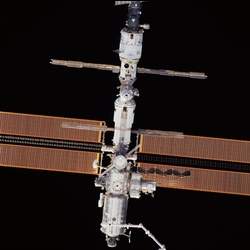 Cabana
said that the Expedition 6 crewmembers aboard the International
Space Station are “grieving” for the loss of
Columbia’s crew, but are in good spirits as they continue
human spaceflight and scientific research aboard the orbital
outpost. Cabana said Commander Ken Bowersox, Flight Engineer
Nikolai Budarin and NASA ISS Science Officer Don Pettit are
preparing for Tuesday’s arrival of a Russian Progress cargo
ship. Progress 10 was launched this morning from the Baikonur
Cosmodrome in Kazakhstan.
Cabana
said that the Expedition 6 crewmembers aboard the International
Space Station are “grieving” for the loss of
Columbia’s crew, but are in good spirits as they continue
human spaceflight and scientific research aboard the orbital
outpost. Cabana said Commander Ken Bowersox, Flight Engineer
Nikolai Budarin and NASA ISS Science Officer Don Pettit are
preparing for Tuesday’s arrival of a Russian Progress cargo
ship. Progress 10 was launched this morning from the Baikonur
Cosmodrome in Kazakhstan.
On Tuesday, Feb. 4, President and Mrs. Bush will join NASA
Administrator Sean O’Keefe at the Johnson Space Center to pay
tribute to Columbia’s astronauts during a special memorial
service. The ceremony to honor Columbia’s seven crewmembers
is scheduled to begin at 1 p.m. EST and will be broadcast on NASA
Television. The service is not open to the public.
STS-107 Report #21 Monday, Feb. 3, 2003 - 7:00 p.m.
CST
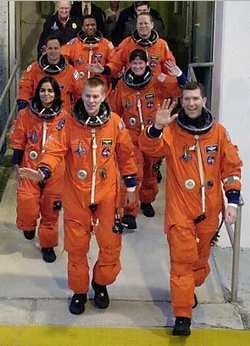 NASA engineers continued to review data and
recover debris from the Space Shuttle Columbia today as the
analysis of what caused the orbiter to break up Saturday en route
to landing continued.
NASA engineers continued to review data and
recover debris from the Space Shuttle Columbia today as the
analysis of what caused the orbiter to break up Saturday en route
to landing continued.
Space Shuttle Program Manager Ron Dittemore told an afternoon
briefing that several teams of engineers are making progress in
their study of data and video from Columbia's launch and entry, but
cautioned that it is a "massive job" requiring round-the-clock
efforts to piece together the events that led to a loss of
communications with the Shuttle over north central Texas 16 minutes
prior to touchdown.
Still, Dittemore said NASA would pause Tuesday for a memorial
ceremony at the Johnson Space Center at 1:00 p.m. EST to honor the
lives and the memory of Columbia's astronauts, Rick Husband,
William McCool, Dave Brown, Kalpana Chawla, Mike Anderson, Laurel
Clark and Ilan Ramon. President and Mrs. Bush will join NASA
Administrator Sean O'Keefe at JSC for the memorial which is closed
to the public, but which will be broadcast on NASA Television.
Dittemore said the memorial represents an opportunity to take
time to remember the sacrifice of the astronauts, to mourn them and
to "remember our friends."
Dittemore offered additional and refined information regarding
the timeline of events that led to Columbia's breakup on Saturday
(all times CST):
- At 7:52 a.m. CST, three-left main gear brake line temperature
sensors showed an unusual rise in the left wheel well area.
- At 7:53 a.m., a fourth left brake line strut actuator
temperature sensor showed a 30-40 degree rise in temperature over a
five-minute period, slightly higher than reported yesterday.
- At 7:55 a.m., A fifth left brake line main gear sensor showed a
sharp rise in temperature.
- At 7:57 a.m., left wing temperature sensors failed "off-scale
low", meaning no further data was being received on the
ground.
- And at 7:59 a.m., just before communications was lost with
Columbia, there was evidence of drag on the aerosurfaces of the
left wing, causing two out of four yaw steering jets in that area
of the Shuttle to fire for 1.5 seconds to counteract the increased
drag.
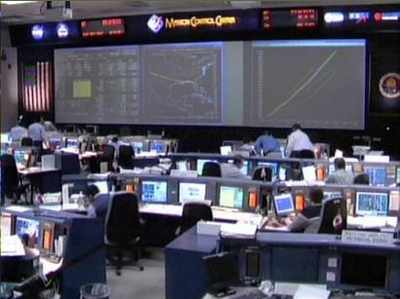
Dittemore said more time will be needed to retrieve an
additional 32 seconds of data acquired by ground computers after
communications was lost with Columbia to see if it is useful to the
inquiry. He said engineers would go directly to the Tracking and
Data Relay Satellite System ground station hub in White Sands, New
Mexico to collect and analyze that data in its pristine form.
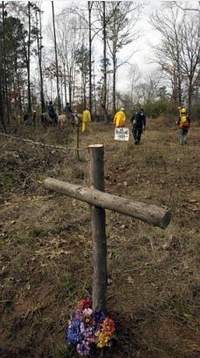 Although the investigative teams have a "high
interest" in the left hand wheel well area of Columbia, Dittemore
cautioned that a temperature increase there does not indicate that
a structural problem occurred as a factor in the vehicle's breakup.
In fact, Dittemore said the data suggests that "something else" may
have been happening at the time, not indicative of a structural
breach.
Although the investigative teams have a "high
interest" in the left hand wheel well area of Columbia, Dittemore
cautioned that a temperature increase there does not indicate that
a structural problem occurred as a factor in the vehicle's breakup.
In fact, Dittemore said the data suggests that "something else" may
have been happening at the time, not indicative of a structural
breach.
Responding to inquiries regarding a piece of foam insulation
which fell off Columbia's external fuel tank about 80 seconds after
launch that struck the left wing of the Shuttle, Dittemore said
imagery analysis showed that the foam measured about 20 inches by
16 inches by 6 inches and weighed about 2.67 pounds. He reiterated
that engineering analysis conducted during the flight concluded for
NASA managers that although the foam might have caused some
structural damage to the wing area, it would not have been
sufficient to cause a catastrophic event.
"There is some other missing link contributing to this event,"
Dittemore said. We are extremely interested in seeing any debris
that may have fallen upstream of the main impact area," referring
to any additional debris which might be recovered in an area to the
west of Texas.
Earlier today, former President George H.W. Bush and Mrs.
Barbara Bush visited the International Space Station flight control
room at the Johnson Space Center, Houston, TX to pay their respects
to the flight controllers and to the Expedition 6 crew aboard the
orbital complex.
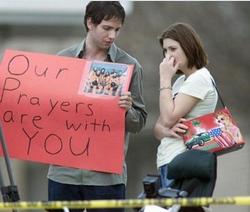 The former president told Expedition 6 Commander
Ken Bowersox, Flight Engineer Nikolai Budarin and NASA ISS Science
Officer Don Pettit that President Bush relayed his "full confidence
in the space program" in a conversation with the elder Bush Sunday.
The former president told the crew the men and women of NASA were
showing "great courage" in the wake of the accident.
The former president told Expedition 6 Commander
Ken Bowersox, Flight Engineer Nikolai Budarin and NASA ISS Science
Officer Don Pettit that President Bush relayed his "full confidence
in the space program" in a conversation with the elder Bush Sunday.
The former president told the crew the men and women of NASA were
showing "great courage" in the wake of the accident.
Bowersox, Budarin and Pettit spent the day preparing for the
docking of a Russian Progress resupply vehicle to the ISS Tuesday
at 9:50 a.m. EST. The new cargo ship, which contains a ton of food,
fuel and supplies for the crew, was successfully launched Sunday
from the Baikonur Cosmodrome in Kazakhstan. NASA TV coverage of the
Progress docking to the ISS begins at 9 a.m. CST Tuesday.
 Aero-News: Quote of the Day (10.24.25)
Aero-News: Quote of the Day (10.24.25) ANN's Daily Aero-Linx (10.24.25)
ANN's Daily Aero-Linx (10.24.25) NTSB Final Report: Cirrus SR22
NTSB Final Report: Cirrus SR22 Airborne-Flight Training 10.23.25: PanAm Back?, Spirit Cuts, Affordable Expo
Airborne-Flight Training 10.23.25: PanAm Back?, Spirit Cuts, Affordable Expo Airborne 10.22.25: Rez Takes Plane, DJI v US Drone Ban, HK 747 Cargo Accident
Airborne 10.22.25: Rez Takes Plane, DJI v US Drone Ban, HK 747 Cargo Accident










